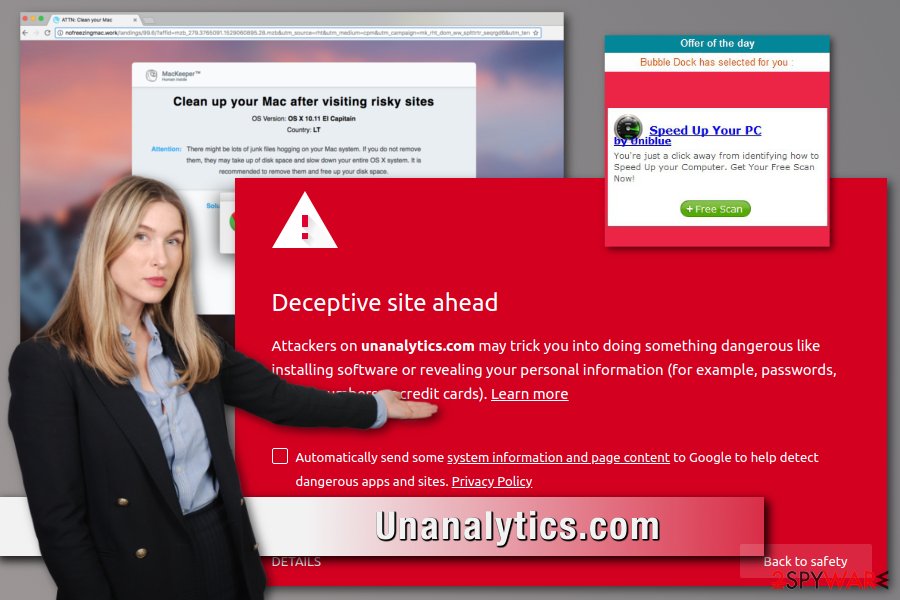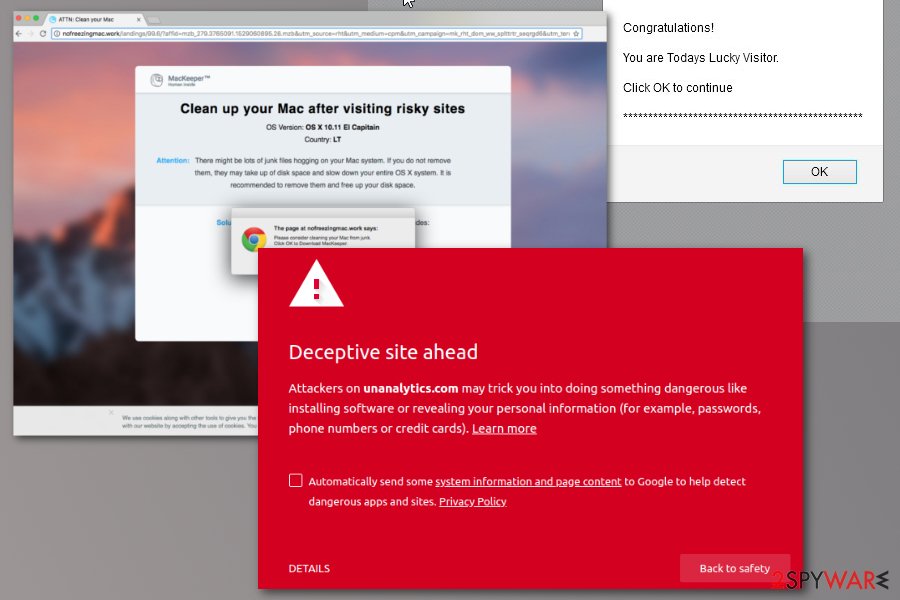Unanalytics.com (virus) - Jun 2021 update
Unanalytics.com Removal Guide
What is Unanalytics.com?
Unanalytics is a platform that leads to advertising sites and even scams

Unanalytics is a potentially dangerous domain that we do NOT recommend visiting. This redirect website is closely related to adware[1] which interrupts people with misleading pop-up ads while they are browsing the Internet. As a result, you can be interrupted by MacKeeper ads, various Tech support scams, and similar ads promoting potentially unwanted programs (PUPs). In addition, the redirect scam can cause fake notifications used to swindle users' personal information by promising tempting prizes, such as iPhone X or Ray-bans. If the virus related to this activity has already infiltrated your system without your permission, make sure you stop its activity before it leads you to malware-filled websites.
| The summary of the cyber threat | |
|---|---|
| Name | Unanalytics.com |
| Type | Adware |
| Danger level | Medium. Can hijack web browsers and redirect to potentially dangerous websites |
| Affected OS | Windows, Mac OS X |
| Targeted browsers | Google Chrome, Mozilla Firefox, Safari, etc. |
| Symptoms | Redirects to questionable sites, an increased amount of ads, installation of shady extensions |
| Repair | Recovering functions and system, files is possible with FortectIntego and similar tools |
| To delete the threat you need to get an anti-malware tool and run a full system scan | |
If you are not attentive enough, you can hardly see how Unanalytics.com infiltrates your computer. It can be related to any PUP, so make sure you double-check every program before letting it into your system. Typically, you just need to deselect check marks that allow the installation of additional components, including browser add-ons and extensions.
Once inside the system, the main issue caused by this redirect virus can be explained as the redirect tendency. When affected, your browsing sessions can be disturbed any minute by a visit to an unknown shopping website, technical support site, or webpage that claims that your PC needs to be cleaned from viruses using suspicious tools.
Unanalytics virus is widely used for promoting questionable software, such as useless PC optimization tools, antivirus programs or malware removal utilities. For example, Mac Tonic, Advanced Mac Cleaner, etc. However, installing them might lead to malware or trojan infiltration. Hence, instead of cleaning your PC, you might actually get it infected.
Researchers from NoVirus.uk[2] report that the online activity of this scam visibly increased in June 2018. This shady application has been noticed promoting MacKeeper – a deceptive application that is supposed to clean Mac computers and laptops – and other fake PC optimization tools. Keep in mind that the use of such software is not recommended as most of such examples bombard their users with fake error notifications and then start offering their paid versions.

Once you buy it, they either stop showing you their exaggerated alerts or remove several hundreds of registry entries that have nothing in common with improved functionality of your PC. So, it is better to decline all offers that come from Unanalytics.com domain and install only expert-reviewed computer tools, products, and services.
According to reports, the page has mostly been interrupting Google Chrome users. After the hijack, it either tries to open a new browser’s tab or loads its own domain instead of the requested one. However, we should also add that Chrome users often receive a “Deceptive site ahead” warning that stops them from visiting this potentially dangerous website. For that, you must always keep your browser up to date.
The latest research data claims that redirects to this suspicious domain are triggered by Better History Chrome extension.[3] This add-on was safe to use until its developer sold it. Since then the add-on was used for suspicious activities. Therefore, Better History extension removal is the first step in Unanalytics.com removal. In order to stop annoying activities on the browser, you need to delete other questionable toolbars or add-ons installed without your consent too.
Additionally, you have to investigate the system and uninstall all shady PC optimization tools, security programs, and other questionable software. You can follow the manual elimination guide that is placed at the end of this article or use a simpler solution to remove Unanalytics.com – automatic elimination with Malwarebytes, SpyHunter 5Combo Cleaner, or your preferred anti-malware software.

Nevertheless, Unanalytics.com is known for injecting tracking cookies that are able to collect various information about the user's browsing activity (e.g. commonly visited pages, browser type, saved bookmarks). Even though the developers in the Privacy Policy describe these cookies are friendly components, note that collected data can be passed on to other parties or used for providing fake but attractive-looking offers:
This website uses its own “cookies” to increase user-friendliness (“cookies” are data records that are sent from the web server to the user’s browser and stored there for later retrieval). No personal data is stored in our own “cookies”. You can generally prevent the use of “cookies” if you prohibit the storage of “cookies” in your browser.
As you can see, there is nothing positive about the page. Besides, VirusTotal has discovered that three antivirus engines find this domain phishing or malicious.[4] If your antivirus also shows these signs, do not postpone the removal process. However, if ads from this site have been coming only on some occasions, you can try preventing their appearance with AdBlock[5] or by completing these manual actions:
- Open the browser app that is showing annoying ads.
- Locate the menu in the upper right corner of your browser window.
- Find the Settings section and continue with Advanced.
- Take a look below Site Settings and you should find Notifications.
- Discover the Unanalytics.com domain and remove it from the notification list.
Ad-supported programs usually sneak into the machine without the user’s knowledge
Adware and other types of PUPs usually spread with the help of freeware and shareware. Developers of free programs are interested in getting profits, so they agree to include additional apps for a specific price. Meanwhile, authors of adware are interested in sneaking into as many computers as possible in order to generate advertising-based revenue too.
Nevertheless, this scheme might seem shady; it’s absolutely legitimate. Though, you need to get used to safe freeware installation practices:
- Download programs from legitimate websites only, meaning forget about torrents and similar file-sharing sites.
- Read Terms of Use and other provided information before installing the program.
- Use Advanced/Custom instead of Recommended/Quick setup.
- Opt-out all third-party apps that are included in the same software package.
Getting rid of the virus from OS and browsers
To remove Unanalytics entirely, you need to uninstall questionable extensions and programs and reset each of the affected web browsers. The guide given below will help you to complete this task. However, if you are not thinking about yourself as an experienced computer user, we suggest using an automatic elimination option as a more trustworthy way while trying to fix the affected computer system.
For automatic Unanalytics removal, use one of the anti-malware apps that we listed down below. All it takes is to install the program, update it and run a full system scan. When your security software cleans the device, you additionally recommend resetting your browser to eliminate virus leftovers, such as tracking cookies and information collected about you.
Unanalytics.com removal process displayed in a video clip
If you have been running into some trouble when trying to remove the program from your computer or browsers, we are here to help you in every way we can. For this purpose, we have even created a detailed video clip in which we have simply shown the entire adware removal process. If you are likely to watch it, click below:
You may remove virus damage with a help of FortectIntego. SpyHunter 5Combo Cleaner and Malwarebytes are recommended to detect potentially unwanted programs and viruses with all their files and registry entries that are related to them.
Getting rid of Unanalytics.com. Follow these steps
Uninstall from Windows
Instructions for Windows 10/8 machines:
- Enter Control Panel into Windows search box and hit Enter or click on the search result.
- Under Programs, select Uninstall a program.

- From the list, find the entry of the suspicious program.
- Right-click on the application and select Uninstall.
- If User Account Control shows up, click Yes.
- Wait till uninstallation process is complete and click OK.

If you are Windows 7/XP user, proceed with the following instructions:
- Click on Windows Start > Control Panel located on the right pane (if you are Windows XP user, click on Add/Remove Programs).
- In Control Panel, select Programs > Uninstall a program.

- Pick the unwanted application by clicking on it once.
- At the top, click Uninstall/Change.
- In the confirmation prompt, pick Yes.
- Click OK once the removal process is finished.
Delete from macOS
:
Remove items from Applications folder:
- From the menu bar, select Go > Applications.
- In the Applications folder, look for all related entries.
- Click on the app and drag it to Trash (or right-click and pick Move to Trash)

To fully remove an unwanted app, you need to access Application Support, LaunchAgents, and LaunchDaemons folders and delete relevant files:
- Select Go > Go to Folder.
- Enter /Library/Application Support and click Go or press Enter.
- In the Application Support folder, look for any dubious entries and then delete them.
- Now enter /Library/LaunchAgents and /Library/LaunchDaemons folders the same way and terminate all the related .plist files.

Remove from Microsoft Edge
Delete unwanted extensions from MS Edge:
- Select Menu (three horizontal dots at the top-right of the browser window) and pick Extensions.
- From the list, pick the extension and click on the Gear icon.
- Click on Uninstall at the bottom.

Clear cookies and other browser data:
- Click on the Menu (three horizontal dots at the top-right of the browser window) and select Privacy & security.
- Under Clear browsing data, pick Choose what to clear.
- Select everything (apart from passwords, although you might want to include Media licenses as well, if applicable) and click on Clear.

Restore new tab and homepage settings:
- Click the menu icon and choose Settings.
- Then find On startup section.
- Click Disable if you found any suspicious domain.
Reset MS Edge if the above steps did not work:
- Press on Ctrl + Shift + Esc to open Task Manager.
- Click on More details arrow at the bottom of the window.
- Select Details tab.
- Now scroll down and locate every entry with Microsoft Edge name in it. Right-click on each of them and select End Task to stop MS Edge from running.

If this solution failed to help you, you need to use an advanced Edge reset method. Note that you need to backup your data before proceeding.
- Find the following folder on your computer: C:\\Users\\%username%\\AppData\\Local\\Packages\\Microsoft.MicrosoftEdge_8wekyb3d8bbwe.
- Press Ctrl + A on your keyboard to select all folders.
- Right-click on them and pick Delete

- Now right-click on the Start button and pick Windows PowerShell (Admin).
- When the new window opens, copy and paste the following command, and then press Enter:
Get-AppXPackage -AllUsers -Name Microsoft.MicrosoftEdge | Foreach {Add-AppxPackage -DisableDevelopmentMode -Register “$($_.InstallLocation)\\AppXManifest.xml” -Verbose

Instructions for Chromium-based Edge
Delete extensions from MS Edge (Chromium):
- Open Edge and click select Settings > Extensions.
- Delete unwanted extensions by clicking Remove.

Clear cache and site data:
- Click on Menu and go to Settings.
- Select Privacy, search and services.
- Under Clear browsing data, pick Choose what to clear.
- Under Time range, pick All time.
- Select Clear now.

Reset Chromium-based MS Edge:
- Click on Menu and select Settings.
- On the left side, pick Reset settings.
- Select Restore settings to their default values.
- Confirm with Reset.

Remove from Mozilla Firefox (FF)
Remove dangerous extensions:
- Open Mozilla Firefox browser and click on the Menu (three horizontal lines at the top-right of the window).
- Select Add-ons.
- In here, select unwanted plugin and click Remove.

Reset the homepage:
- Click three horizontal lines at the top right corner to open the menu.
- Choose Options.
- Under Home options, enter your preferred site that will open every time you newly open the Mozilla Firefox.
Clear cookies and site data:
- Click Menu and pick Settings.
- Go to Privacy & Security section.
- Scroll down to locate Cookies and Site Data.
- Click on Clear Data…
- Select Cookies and Site Data, as well as Cached Web Content and press Clear.

Reset Mozilla Firefox
If clearing the browser as explained above did not help, reset Mozilla Firefox:
- Open Mozilla Firefox browser and click the Menu.
- Go to Help and then choose Troubleshooting Information.

- Under Give Firefox a tune up section, click on Refresh Firefox…
- Once the pop-up shows up, confirm the action by pressing on Refresh Firefox.

Remove from Google Chrome
Delete malicious extensions from Google Chrome:
- Open Google Chrome, click on the Menu (three vertical dots at the top-right corner) and select More tools > Extensions.
- In the newly opened window, you will see all the installed extensions. Uninstall all the suspicious plugins that might be related to the unwanted program by clicking Remove.

Clear cache and web data from Chrome:
- Click on Menu and pick Settings.
- Under Privacy and security, select Clear browsing data.
- Select Browsing history, Cookies and other site data, as well as Cached images and files.
- Click Clear data.

Change your homepage:
- Click menu and choose Settings.
- Look for a suspicious site in the On startup section.
- Click on Open a specific or set of pages and click on three dots to find the Remove option.
Reset Google Chrome:
If the previous methods did not help you, reset Google Chrome to eliminate all the unwanted components:
- Click on Menu and select Settings.
- In the Settings, scroll down and click Advanced.
- Scroll down and locate Reset and clean up section.
- Now click Restore settings to their original defaults.
- Confirm with Reset settings.

Delete from Safari
Remove unwanted extensions from Safari:
- Click Safari > Preferences…
- In the new window, pick Extensions.
- Select the unwanted extension and select Uninstall.

Clear cookies and other website data from Safari:
- Click Safari > Clear History…
- From the drop-down menu under Clear, pick all history.
- Confirm with Clear History.

Reset Safari if the above-mentioned steps did not help you:
- Click Safari > Preferences…
- Go to Advanced tab.
- Tick the Show Develop menu in menu bar.
- From the menu bar, click Develop, and then select Empty Caches.

After uninstalling this potentially unwanted program (PUP) and fixing each of your web browsers, we recommend you to scan your PC system with a reputable anti-spyware. This will help you to get rid of Unanalytics.com registry traces and will also identify related parasites or possible malware infections on your computer. For that you can use our top-rated malware remover: FortectIntego, SpyHunter 5Combo Cleaner or Malwarebytes.
How to prevent from getting adware
Access your website securely from any location
When you work on the domain, site, blog, or different project that requires constant management, content creation, or coding, you may need to connect to the server and content management service more often. The best solution for creating a tighter network could be a dedicated/fixed IP address.
If you make your IP address static and set to your device, you can connect to the CMS from any location and do not create any additional issues for the server or network manager that needs to monitor connections and activities. VPN software providers like Private Internet Access can help you with such settings and offer the option to control the online reputation and manage projects easily from any part of the world.
Recover files after data-affecting malware attacks
While much of the data can be accidentally deleted due to various reasons, malware is one of the main culprits that can cause loss of pictures, documents, videos, and other important files. More serious malware infections lead to significant data loss when your documents, system files, and images get encrypted. In particular, ransomware is is a type of malware that focuses on such functions, so your files become useless without an ability to access them.
Even though there is little to no possibility to recover after file-locking threats, some applications have features for data recovery in the system. In some cases, Data Recovery Pro can also help to recover at least some portion of your data after data-locking virus infection or general cyber infection.
- ^ Adware. Wikipedia. The free encyclopedia.
- ^ No Virus. No Virus. British cyber security news.
- ^ Chrome Extension Better History is Malicious, Remove It Immediately. Techdows. Latest technology news.
- ^ 3 engines detected this URL. Virus Total. URL Investigation.
- ^ What is AdBlock?. Quora.com. Relevant questions and answers.























